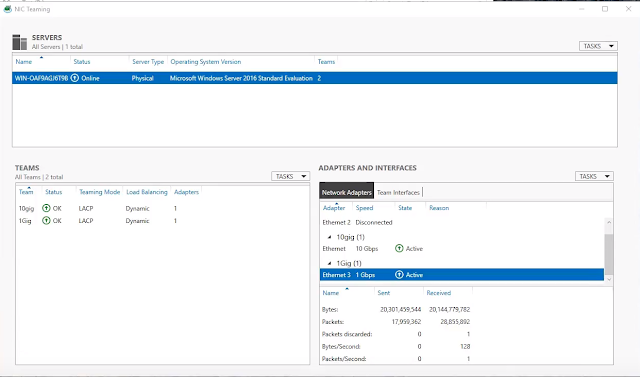This post will go over how to setup a 10 gig link with a 1gig failover between Windows and FreeNAS using a Cisco Meraki Stack. The FreeNAS Server is setup using a FAILOVER link aggregation which allows the FreeNAS Server to keep it's IP address in the event of a switch or link failure. The Meraki Stack has the Windows Server setup for LACP for aggregation on port 1 on 125.46 and port 24 on 125.47. FreeNAS is set up for LACP for aggregation on port 1 on 125.27 and port 24 on 125.46. LACP automatically disables the slower port and it is used in a FAILOVER mode as shown in the image below.
 |
| Meraki Stack Setup
The Windows Connection is setup as two different network interfaces with 2 different IP addresses. As shown in the image below there is a 10 gig network interface and a 1 gig network interface. These interfaces cannot be aggregated together, if you do they will not operate properly.
|
 |
| Windows Network Interface Setup |

| FreeNAS Network Setup For FAILOVER aggregation
The Windows Server for the Hyper-V Server or just as the host has actually two different IP addresses as stated before. This should not be a problem if your using it as a Hyper-V host as the VM's that you are running will get it's traffic from the failover connection should the primary connection fails.
Before our failover here are some benchmarks of our FreeNAS connection using the iSCSI Connector
As you can see we are pretty much saturating the network bandwidth of the 10gig link, and now when we cause a failure (in this case I disconnected the 10Gig link) the Storage hesitates for a few seconds before re-routing the network traffic through the failover link.
Windows Showing a failure in the 10 gig link
Once the failure in the link is auto detected port 1 on 125.47 is no longer disabled in the Meraki Stack and the server continues to operate as it should just at a reduced capacity and performance.
The Meraki enables the 1gig link to allow network traffic to continue to flow to the iSCSI target
The Windows server and FreeNAS continue to operate and communicate with eachother but in a reduced capacity until the primary 10 gig link can be restored.
When failing the link back there is no noticeable interruption that I was able to notice from Windows, FreeNAS or the switches. The only noticeable interruption was when the failure occurred and I doubt it would be noticeable unless it was some application that need to work in real time. During the failover I wouldn't even call the event a hiccup it went that smooth. My testing included killing the power from an entire switch in the stack, and killing each link on both switch on both servers.
I must say I was really very impressed by how well the failover worked and I can't wait to get this setup into our production environment.
|







